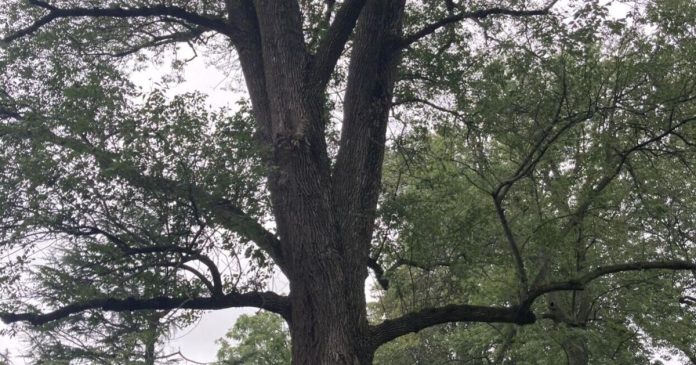IIn the last article in this three-part series, we mentioned that a healthy tree has a full canopy, few dead branches, dense bark, broad buttress roots, a trunk close to the ground, a structurally sound shape, and emphasizes its growing space. Knowing how to recognize a healthy tree will make it easier for you to determine if a particular tree is unhealthy, since an unhealthy tree deviates from these ideals.
Similar to our skin, the bark of the tree fulfills an important function. The bark protects the inner sapwood and hardwood from drying out and is a barrier to insects, disease and other pathogens. Healthy bark should wrap tightly around the tree, be of an even consistency, with no unusual growths or foul-smelling liquids exuding. Tree bark has many textures characteristic of each species.
Recognizing these bark features helps identify trees in winter when leaves are absent. Trees like shagbark hickory, sycamore, river birch, or white oak are easy to spot because their bark is so characteristic of the tree. While we may not be able to identify all trees by their bark, we can look for inconsistencies in the bark when reviewing it. Sometimes the bark is damaged with small holes, cracks or very large wounds.
Construction machinery, cars, large animals, poor pruning practices that rip off excess bark, lightning strikes, or small animals like squirrels can damage the bark and cause a wound on the tree. Hopefully this wound will heal quickly before rot or other pathogens can enter the tree. The size of the wound, the health of the tree, and other factors play an important role in how quickly the tree can cover the wound with new bark.
Some wounds are so large that they never heal and rot forms in the tree. Over time, the rotten wood can decompose and a cavity remains in the tree. Pathogens such as beech bark disease, hypoxylon canker or dogwood anthracnose can act on the bark and cause damage to the inner and outer bark in the form of a canker. Diseases of the bark can also result in discoloration, fungus, or foul-smelling lesions. Nectria canker and bacterial mucus flow are examples of diseases that result in bark discoloration and foul-smelling lesions.
Some harmful insects such as the emerald ash borer, pine bark beetle and ips beetle burrow into the inner bark to feed on the sapwood. This damage can disrupt the water and nutrient transport system, introduce disease, stunt tree growth, and ultimately lead to tree death.
The emerald ash borer has devastated most of our ash trees since it was discovered in the late 2000s. Some thin-barked trees, such as beech or sugar maple, may suffer from sunburn if their bark has recently been exposed to intense direct sunlight from a severe pruning that removed most of the leaves exposing the trunk. Trees with thin bark can also develop frost cracks in winter when the bark is warmed up by the sun on an otherwise very cold day. Frost cracks generally develop on trees that are close to a surface that reflects sunlight, such as a tree. B. a concrete sidewalk. Sometimes tree bark is damaged by mowers or weed cutters. Placing a layer of mulch next to a landscape tree will suppress lawn grass and weed growth, reducing the need to mow closely.
The roots of the tree fulfill very important functions in absorbing water and soil nutrients and in anchoring the tree in the soil. A healthy tree usually has strong basal roots that spread away from the tree, making it appear as if the trunk has a swelling near the ground. If you see a tree that has no swelling near the trunk, one that looks more like a telephone pole, it could be the result of girdle roots wrapping around the trunk of the tree. This condition could result in large portions of the tree being strangled.
Damage to the main buttress roots from equipment, vehicles, animals, etc. can impair root function and make the tree unstable, making it easier for it to tip over. Along with buttress roots, trees have an intricate system of small fleshy forage roots that extend to or beyond the edge or “dripline” of the tree and are located near the surface. The purpose of these feed roots is to obtain water and soil nutrients. Because these feeder roots are fragile and located near the surface, they are susceptible to damage from digging, soil compaction, and excessively wet or dry conditions. Any disturbances around the tree, including extremely wet or dry conditions, can affect the growth and vitality of the forage roots, which can ultimately affect the health of the tree. The recent decline of many large and old oak trees in our area has been attributed to wet conditions damaging the roots of forage crops and introducing disease to the tree.
Michael Kay is a member of the Frederick County Forestry Board.
www.fredericknewspost.com
https://www.fredericknewspost.com/news/environment/tree-care/article_721a90f5-9883-562c-89e2-6e2bc378dcc1.html















